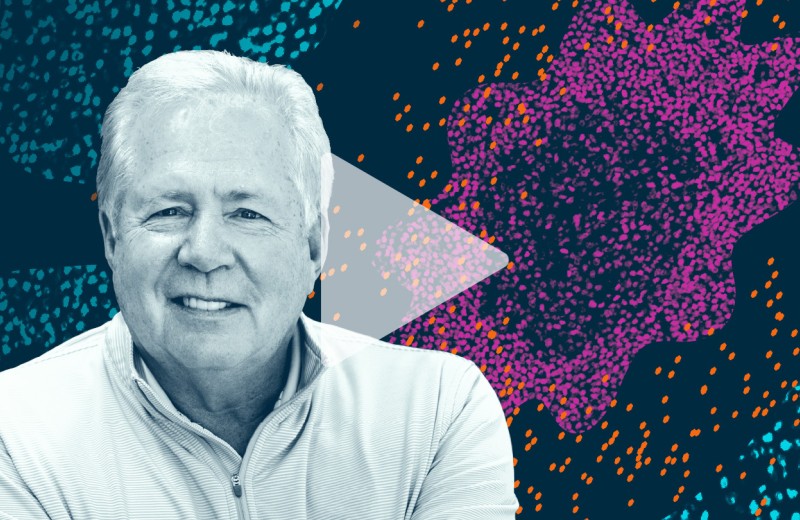
Bob Grant is working to better implement pre-exposure prophylaxis (PrEP) for the prevention of HIV, and he's combating the fear, stigma, and lack of awareness that still plague programs that aim to provide HIV treatment and prevention. [Photo: Chris Goodfellow]
We have never been closer to achieving our goal of ending new HIV infections. This promising news is due to the successful implementation and integration of HIV treatment programs, such as antiretroviral therapy (ART) to combat HIV in infected individuals, and prevention programs that integrate pre- and post-exposure prophylaxis (PrEP and PEP, respectively) to protect people from contracting the virus.
Since my lab at the Gladstone Institutes first proved the concept of PrEP—the strategy of using anti-HIV drugs to stop transmission—in 2010, numerous studies have demonstrated its effectiveness at preventing new infections. Most recently, a study of more than 650 gay men on PrEP resulted in no new cases over a two-and-a-half year period. Other trials have shown that HIV infection is extremely rare when PrEP is made available to people at risk for acquiring infection.
In the past year, there has been more than a 300% increase in the demand for PrEP nationwide. Truvada—the brand name for the combination of ART drugs emtricitabine and tenofovir disoproxil fumarate used for PrEP—was approved by the FDA in 2012, and it was recommended for HIV prevention by the Centers for Disease Control and Prevention (CDC) in 2014 and by the World Health Organization (WHO) in 2015. In San Francisco, long deemed an epicenter of the AIDS crisis, an estimated 10 to 15% of gay men are taking PrEP, and HIV infection rates dropped to an all-time low of 302 new cases in the last year, down 29% since 2012.
What’s more, being on PrEP does not cause people to be reckless or take more risks with their health. Instead, many PrEP users become more aware of their safety, and they take additional precautions. PrEP transforms denial and paralyzing fear of HIV into a willingness to think about risks and take action to stay safe.
The success seen in San Francisco leads us to believe that a global reduction in HIV transmission is possible following a comprehensive scale-up of PrEP. However, while we’ve made great strides in our efforts to end HIV transmission, there is still substantial work to be done. My focus at Gladstone is now on how best to implement PrEP and combat the fear, stigma, and lack of awareness that still plague the broader scale up of programs that aim to provide HIV treatment and prevention.
A Holistic Approach to Sexual Health
Rather than take a narrow focus emphasizing the absence of disease, we advocate a comprehensive approach to HIV prevention that incorporates the whole being. This means we should be realistic about individuals’ motivations and take into account people’s reproductive and sexual desires, in addition to their longevity goals.
For most people, treating or preventing HIV is one objective among many. If we focus on one specific aspect of a person, namely their risk for contracting HIV, we will fail to engage them most effectively. Indeed, without this holistic perspective, behaviors and habits are unlikely to change, and treatment drop-outs or lapses in adherence to the medication are likely. As such, HIV prevention (and treatment) should be incorporated into the rest of a person’s life.
This strategy is borrowed from the earlier success of perinatal HIV prevention, which transitioned from concentrating purely on disease transmission to incorporating maternal health as the primary focus. Widely heralded as one of the greatest public health successes, perinatal HIV transmissions declined in the United States from 1,650 in 1991 to 151 by 2009, a greater than 90% reduction.
Lessons from the achievements seen in perinatal HIV transmission can and should be applied to the fight against sexual HIV transmission. Based on this approach, we believe three factors would help contribute to the eradication of HIV:
1) Routine HIV testing,
2) An integrated treatment and prevention strategy,
3) Champions rallying around a compelling message.
Broader Implementation of HIV Testing
A key component of preventing new infections is regular monitoring and testing for HIV, particularly among people at risk. Regardless of the type of therapy initiated, HIV testing is typically the entry point. Individuals concerned about a recent potential exposure come in for testing and should be given PEP; people worried about a generally elevated risk ideally are tested frequently and seek out PrEP; and new cases of HIV are identified through testing and should be immediately prescribed ART.
Rather than wait for warning signs, routine screenings will help avoid the further spread of HIV once a person is infected. At least twenty-five percent of individuals with HIV are not on ART, and a greater emphasis on regular testing would help mitigate that problem. Testing also offers the opportunity for those in need to start treatment immediately, or make PrEP available for those concerned about an ongoing risk for infection. Thus, increasing regular testing, particularly among those at higher risk for infection, is of vital importance.
Combining Prevention and Treatment Strategies
Routine testing is also critical in identifying opportunities to integrate treatment and prevention programs. We advocate a seamless transition between pre- (PrEP) and post-exposure (PEP) prophylaxis and ART in cases where it’s needed. For example, following possible HIV exposure, a person should undergo PEP therapy. Upon completion of PEP, the individual should immediately enroll in PrEP after completion of the PEP course. In another scenario, if someone contracts HIV while on PrEP, then rapid initiation of ART is of the utmost importance.
In a recent review article, we describe practical support for the conversion from PEP to PrEP, or from either PEP or PrEP to ART. The novelty of this concept has delayed its integration into clinical practice. With these guidelines, we show simple pathways for optimizing HIV treatment and prevention that most clinicians can adopt.
Champions for a Cause
To assist with the implementation of these recommendations, policies from agencies like the CDC and the WHO are critical. In 2014, I co-wrote the guidelines for the CDC endorsing the use of PrEP to stop the spread of HIV. More recently, I helped the WHO issue their recommendation of PrEP to prevent transmission. These broad-reaching endorsements are having a powerful impact on reassuring people of the safety and effectiveness of PrEP, and they are positively influencing prevention efforts both nationally and internationally.
However, local champions in the community are just as important. These advocates may be researchers, clinicians, patients, family members, staff, or people who read the news. Champions can arise anywhere. Regardless of the origin of their interest, the best activist is a passionate individual who is an early adopter of the mission and methods.
One place to look for champions is the transgender community. These individuals are often on the front lines of social and cultural movements, and health is no different. In one recent investigation, we demonstrated that, when taken as prescribed, transgender women did not contract HIV. However, there were additional barriers to PrEP use in this population, particularly among those at the highest risk. Our next step is to optimize PrEP for transgender women, with the hope that this will help expand use of PrEP in this group. In collaboration with the UCSF Center for Excellence in Transgender Health, my lab at Gladstone was recently awarded funding to start the first PrEP clinic for transgender people, which combines gender affirming care with potent methods for HIV prevention.
As humans, we need social contact, even to the extent of prioritizing it over longevity. To protect ourselves from unnecessary risk, it is important to acknowledge that our quest for connection may cause us to make mistakes. By maintaining this awareness and arming ourselves with all of the tools available—including prevention and treatments—we will make great strides toward our goal of ending HIV transmission.
Robert Grant, MD, MPH, is a Senior Investigator at the Gladstone Institutes. He is also the Betty Jean and Hiro Ogawa Endowed Investigator at Gladstone and a Professor of Medicine at the University of California, San Francisco.
For more stories about Gladstone's cutting-edge biomedical research, visit our News & Highlights.
Support Discovery Science
Your gift to Gladstone will allow our researchers to pursue high-quality science, focus on disease, and train the next generation of scientific thought leaders.
How Understanding RNA Structure Can Help Researchers Design Better HIV Drugs
How Understanding RNA Structure Can Help Researchers Design Better HIV Drugs
New research sheds light on the biological effect of the many possible three-dimensional structures of a critical loop of RNA in HIV
Research (Publication) HIV/AIDS Virology Ott Lab40 Years of HIV Research: Celebrating the Career of Virologist Warner Greene
40 Years of HIV Research: Celebrating the Career of Virologist Warner Greene
Colleagues look back on Warner Greene's 40 year career
Gladstone Experts History HIV/AIDS Virology Greene LabIn Conversations with Adam Castillejo, the London Patient
In Conversations with Adam Castillejo, the London Patient
Watch this panel discussion that addresses the impact and hurdles associated with developing a cure for HIV
HIV/AIDS Ott Lab



